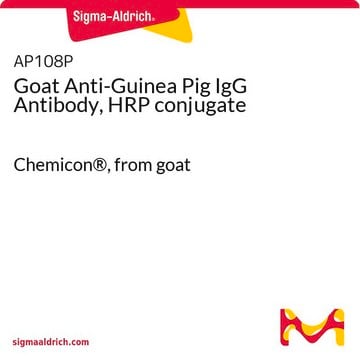F6261
Anti-Guinea Pig IgG (whole molecule)−FITC antibody produced in goat
affinity isolated antibody, buffered aqueous solution
Synonym(s):
Goat Anti-Guinea Pig IgG (whole molecule)−Fluorescein isothiocyanate
About This Item
Recommended Products
biological source
goat
conjugate
FITC conjugate
antibody form
affinity isolated antibody
antibody product type
secondary antibodies
clone
polyclonal
form
buffered aqueous solution
technique(s)
direct immunofluorescence: 1:64
storage temp.
2-8°C
target post-translational modification
unmodified
Related Categories
General description
Anti-Guinea Pig IgG (whole molecule)-FITC antibody is specific for guinea pig IgG subclasses. Goat anti-Mouse IgG is purified by affinity isolation and conjugated to FITC.
The suitability of any secondary antibody to a specific immunodetection application is dependent upon its signal development system configuration. Signal development systems are based upon the chemical conjugation of a signal mediator to the secondary antibody. Major secondary antibody signal systems are color (chromogenic), chemiluminescence or fluorescence based and involve the use of enzymes or high affinity binary systems such as biotin:avidin.
Fluorescein isothiocyanate (FITC) is a fluorescein derivative (fluorochrome) used to tag antibodies, including secondary antibodies, for use in fluorescence-based assays and procedures. FITC excites at 495 nm and emits at 521 nm.
Immunogen
Application
Physical form
Disclaimer
Not finding the right product?
Try our Product Selector Tool.
Storage Class Code
10 - Combustible liquids
WGK
WGK 2
Flash Point(F)
Not applicable
Flash Point(C)
Not applicable
Certificates of Analysis (COA)
Search for Certificates of Analysis (COA) by entering the products Lot/Batch Number. Lot and Batch Numbers can be found on a product’s label following the words ‘Lot’ or ‘Batch’.
Already Own This Product?
Find documentation for the products that you have recently purchased in the Document Library.
Our team of scientists has experience in all areas of research including Life Science, Material Science, Chemical Synthesis, Chromatography, Analytical and many others.
Contact Technical Service








